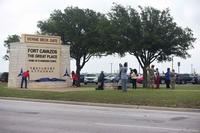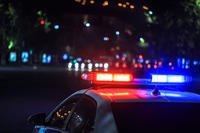From his vantage point on Brooklyn Heights, Gen. George Washington watched as the hopelessly outnumbered "Maryland 400" charged again and again to stop the advance of the British regulars and their Hessian mercenaries.
According to the historians, Washington turned to Gen. Israel Putnam and said, "Great God, what brave fellows I must this day lose" in halting the rout of his Continental Army in the 1776 Battle of Brooklyn, often called the Battle of Long Island -- the bloodiest and biggest of the Revolutionary War. Washington would later dub the 1st Maryland the "Bayonets of the Revolution."
The British were closing in to destroy Washington's forces and end the rebellion against King George III on the afternoon of Aug. 27, 1776, but the surprise attack of the Marylanders drove them back up what is now called Park Slope before faltering.
The charge broke the British lines at the Vechte-Cortelyou House, better known as the "Old Stone House," now the centerpiece of a playground at Fifth Avenue and Third Street.
Legend has it that British Gen. Sir Charles Cornwallis, who would surrender the British army at Yorktown, Va., in 1781, hid in the attic of the Old Stone House until British troops retook the position.
The charge gave fateful pause to Sir William Howe, the British commander. If this was how the colonial riffraff fought when cornered, he would not pursue them in the fading light. He planned to begin a siege of Brooklyn Heights in the morning. The fleet of his brother, Lord Richard Howe, would pound the Americans from the East River and force surrender.
The charge also gave Washington time.
In one of the most remarkable episodes in the history of warfare, Brig. Gen. John Glover and his Marblehead (Mass.) boatmen, aided by a night fog, came across from Manhattan and evacuated Washington and his entire army -- 9,000 troops, horses and cannon -- without a single loss of life.
The Howe brothers were flummoxed and later had to explain themselves to Parliament.
Washington himself was the last to board the flatboats. He would lose again in Manhattan and at White Plains, but he would go on to win the war.
In their fury at being pushed back, the Hessians are believed to have bayoneted survivors and thrown the bodies of 256 of the Marylanders into a hastily dug common grave, which has never been found.
Mass Grave Found?
Now there is another battle of Brooklyn underway over an unsightly empty lot at Ninth Street and Third Avenue, where preservationists suspect the remains of the 256 might at last be uncovered.
There have been numerous attempts to find the remains in the past but this time, the Marylanders have a British recruit to advocate for them in Sir Patrick Stewart, the distinguished actor who played Capt. Jean-Luc Picard in "Star Trek: The Next Generation."
Stewart, who has a renovated brownstone a few blocks from the empty lot, told GQ magazine he's convinced that the remains can be found there. The lot is just "a concreted-over car park," Stewart said, "but underneath the concrete is the mass grave. It's worth making, I think, a bit of a fuss of. Over 200 were buried here."
Stewart has made a fuss to New York City Mayor Bill de Blasio, who told him "I'm on it," but the city already has tentative plans to buy the lot for a pre-kindergarten facility.
De Blasio spokeswoman Melissa Grace told The New York Post that the lot "is part of an ongoing environmental review. The Landmarks Preservation Commission is coordinating with the State Historic Preservation Office on this archaeological question."
"We note that, at this time, no one knows the location of these burials or the likelihood of remains being found at this location," Grace said.
However, the members of Michael A. Rawley Jr. American Legion Post 1636, which is next door to the empty lot on Ninth Street, and Robert Furman, president of the Brooklyn Preservation Council, have called for an archaeological dig before the city makes any moves on the lot.
"We owe it to those who died to find out if they're buried here," Furman told The Baltimore Sun. "It would be a horrible travesty if something were to be built here without finding out if Revolutionary War heroes who gave their lives for our freedom are buried here and we just built on top of it."
Revolutionary War Heroes
One of those heroes was young rebel William Sands, who joined with the Maryland militia volunteers who marched to Brooklyn in the summer of 1776.
Billy Sands sent letters home to his "Honoured Father and Respected Mother" that were later found in a Maryland attic and are now part of the Maryland archives.
In a letter dated July 20, 1776, and sent from Philadelphia along the way to New York, Billy tried, not too convincingly, to squelch a rumor started by someone else in his unit that his girlfriend had stowed away in the baggage train and was following him. Yes, there was a girl, Billy said, but surely he didn't know her.
In his last letter dated Aug. 14, 1776, Billy was writing from a hill in what is now Greenwood Cemetery, watching in awe as the might of the British Empire assembled in the Narrows and Gravesend Bay to crush him and the infant America.
"About 200 ships of the King's sail lay close by us," Billy wrote. "We are ordered to hold ourselves in readiness. We expect an attack hourly." He added, "We expect, please God, to winter in Annapolis, those that live of us."
The historians believe William Sands was among those killed in the valiant charge against the British. If there really was a girlfriend, there is no record of her.
The historians say that the fleet the British sent against the Americans was the largest since the Spanish Armada in 1588 and the estimated 30,000 troops the ships landed on Staten Island and in Brooklyn amounted to the largest invasion force until D-Day in 1944.
Howe Tries to Explain
In 1779, Sir William Howe tried to explain to Parliament why, with all that firepower brought together against the greatly outnumbered Americans, he ordered the attack to halt rather than pressing on against Washington on Brooklyn Heights.
Howe thought Washington and his ragtag troops would seek surrender at the mere sight of the British fleet and the embarkation force. He sent a letter through an emissary under a flag of truce addressed to "George Washington, Esq."
The Americans rejected it as insulting for failing to address Washington as a general. Howe sent another letter addressed to "George Washington, Esq, etc. etc." Howe offered pardons to Washington and his army if they surrendered. Washington wrote back: "Those who have committed no fault want no pardon."
In speaking to his order to halt the attack, Howe apparently had in mind the heavy casualties suffered by the British earlier in attacking Bunker Hill in Charlestown near Boston.
He told Parliament, "The loss of 1,000, or perhaps 1,500 British troops, in carrying those lines [in Brooklyn], would have been but ill repaid by double that number of the enemy, could it have been supposed they would have suffered in that proportion."
In Brooklyn's Prospect Park, there's a monument to the Maryland 400 donated in 1895 by the Maryland Society of the Sons of the American Revolution and designed by the famed architect Stanford White.
It's on what is officially called Lookout Hill. In Brooklyn, it's just Monument Hill. On one side of the monument is the inscription of Washington's quote: "Great God what brave fellows I must this day lose."
Down the slope from Prospect Park, there's a plaque over the door leading to the bar at the Michael A. Rawley Jr. American Legion Post 1636. It reads: "In Honored Memory of Maryland's 400. Forever Remembered."
-- Richard Sisk can be reached at Richard.Sisk@Military.com.





























